Holmes Institute - HI6006: Competitive Strategy Development Essay
VerifiedAdded on 2022/09/21
|9
|2110
|22
Essay
AI Summary
This essay, prepared for the HI6006 Competitive Strategy unit at Holmes Institute, comprehensively analyzes three key strategic development tools: SWOT Analysis, Porter’s Generic Strategies, and the Ansoff Matrix. The essay begins by defining strategy development and its importance in today's competitive market. The SWOT analysis section delves into identifying strengths, weaknesses, opportunities, and threats, providing examples from BHP Billiton. The discussion on Porter's Generic Strategies covers cost leadership, differentiation, and focus strategies, with examples such as Aldi and Apple. The Ansoff Matrix is then explained, outlining market penetration, product development, market development, and diversification strategies, again using real-world business examples like Wesfarmers and Samsung. The essay concludes by summarizing the application of these tools in achieving competitive advantage and performing internal and external company analysis. References are provided using the Harvard referencing style.
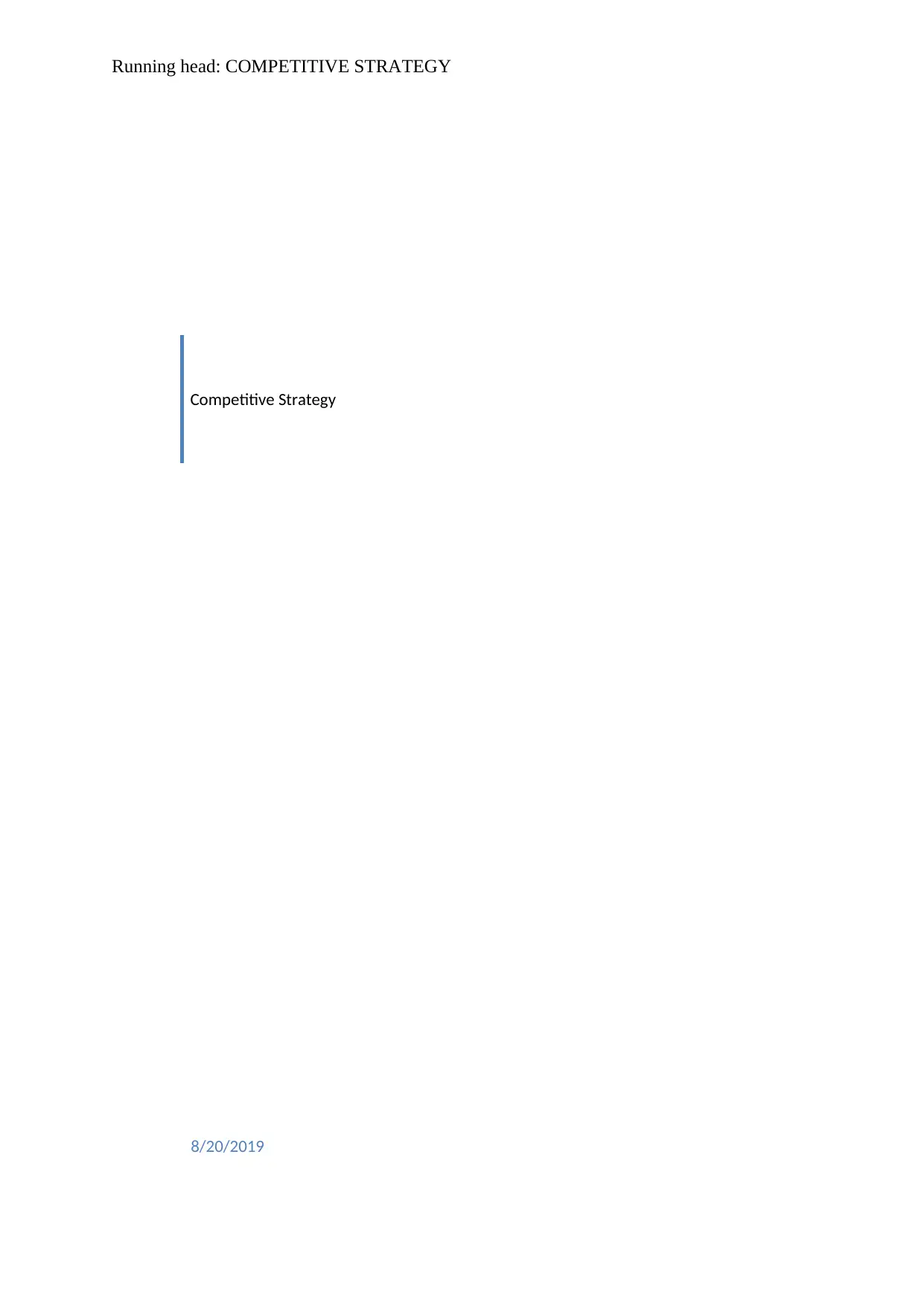
Running head: COMPETITIVE STRATEGY
Competitive Strategy
8/20/2019
Competitive Strategy
8/20/2019
Paraphrase This Document
Need a fresh take? Get an instant paraphrase of this document with our AI Paraphraser
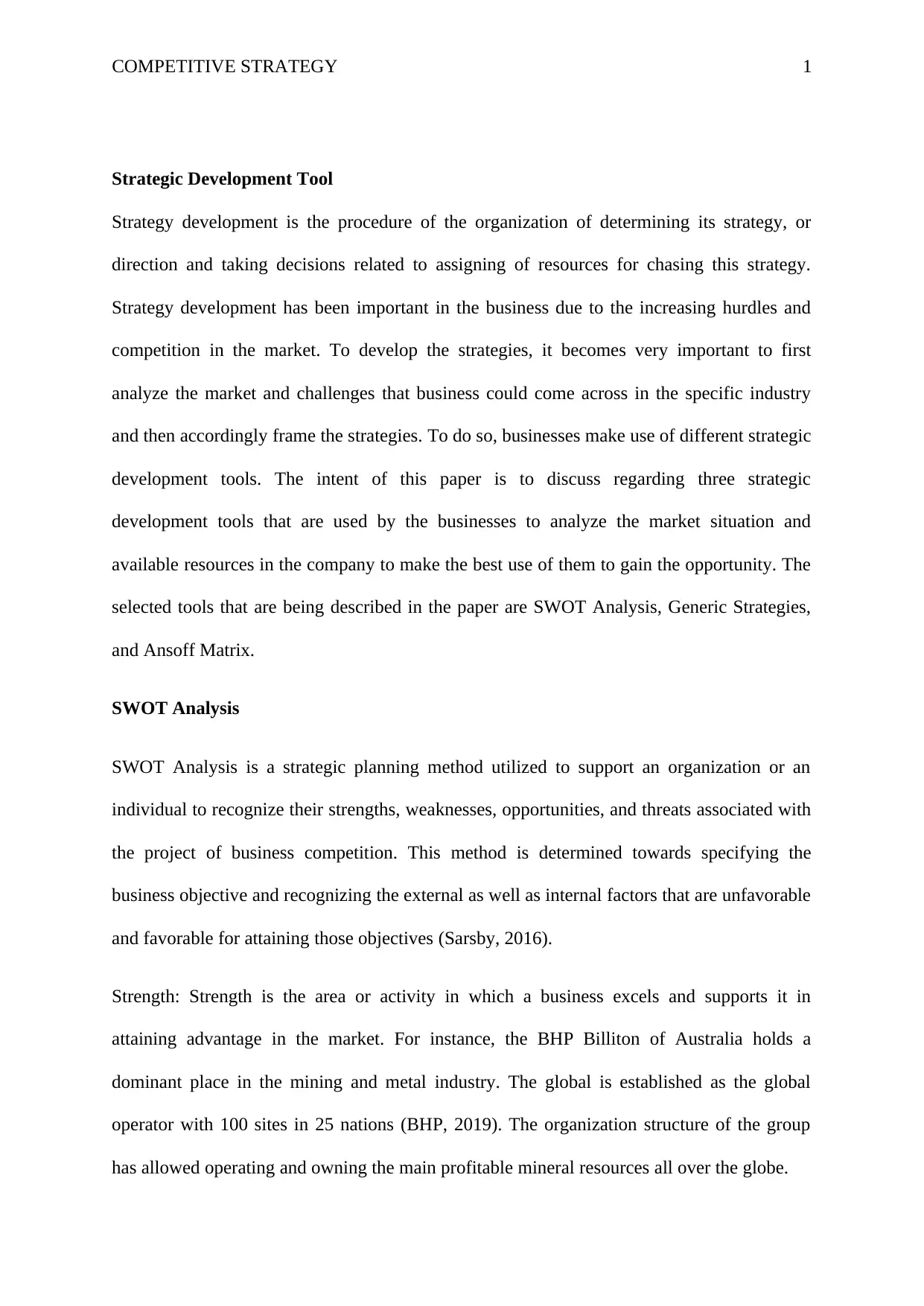
COMPETITIVE STRATEGY 1
Strategic Development Tool
Strategy development is the procedure of the organization of determining its strategy, or
direction and taking decisions related to assigning of resources for chasing this strategy.
Strategy development has been important in the business due to the increasing hurdles and
competition in the market. To develop the strategies, it becomes very important to first
analyze the market and challenges that business could come across in the specific industry
and then accordingly frame the strategies. To do so, businesses make use of different strategic
development tools. The intent of this paper is to discuss regarding three strategic
development tools that are used by the businesses to analyze the market situation and
available resources in the company to make the best use of them to gain the opportunity. The
selected tools that are being described in the paper are SWOT Analysis, Generic Strategies,
and Ansoff Matrix.
SWOT Analysis
SWOT Analysis is a strategic planning method utilized to support an organization or an
individual to recognize their strengths, weaknesses, opportunities, and threats associated with
the project of business competition. This method is determined towards specifying the
business objective and recognizing the external as well as internal factors that are unfavorable
and favorable for attaining those objectives (Sarsby, 2016).
Strength: Strength is the area or activity in which a business excels and supports it in
attaining advantage in the market. For instance, the BHP Billiton of Australia holds a
dominant place in the mining and metal industry. The global is established as the global
operator with 100 sites in 25 nations (BHP, 2019). The organization structure of the group
has allowed operating and owning the main profitable mineral resources all over the globe.
Strategic Development Tool
Strategy development is the procedure of the organization of determining its strategy, or
direction and taking decisions related to assigning of resources for chasing this strategy.
Strategy development has been important in the business due to the increasing hurdles and
competition in the market. To develop the strategies, it becomes very important to first
analyze the market and challenges that business could come across in the specific industry
and then accordingly frame the strategies. To do so, businesses make use of different strategic
development tools. The intent of this paper is to discuss regarding three strategic
development tools that are used by the businesses to analyze the market situation and
available resources in the company to make the best use of them to gain the opportunity. The
selected tools that are being described in the paper are SWOT Analysis, Generic Strategies,
and Ansoff Matrix.
SWOT Analysis
SWOT Analysis is a strategic planning method utilized to support an organization or an
individual to recognize their strengths, weaknesses, opportunities, and threats associated with
the project of business competition. This method is determined towards specifying the
business objective and recognizing the external as well as internal factors that are unfavorable
and favorable for attaining those objectives (Sarsby, 2016).
Strength: Strength is the area or activity in which a business excels and supports it in
attaining advantage in the market. For instance, the BHP Billiton of Australia holds a
dominant place in the mining and metal industry. The global is established as the global
operator with 100 sites in 25 nations (BHP, 2019). The organization structure of the group
has allowed operating and owning the main profitable mineral resources all over the globe.
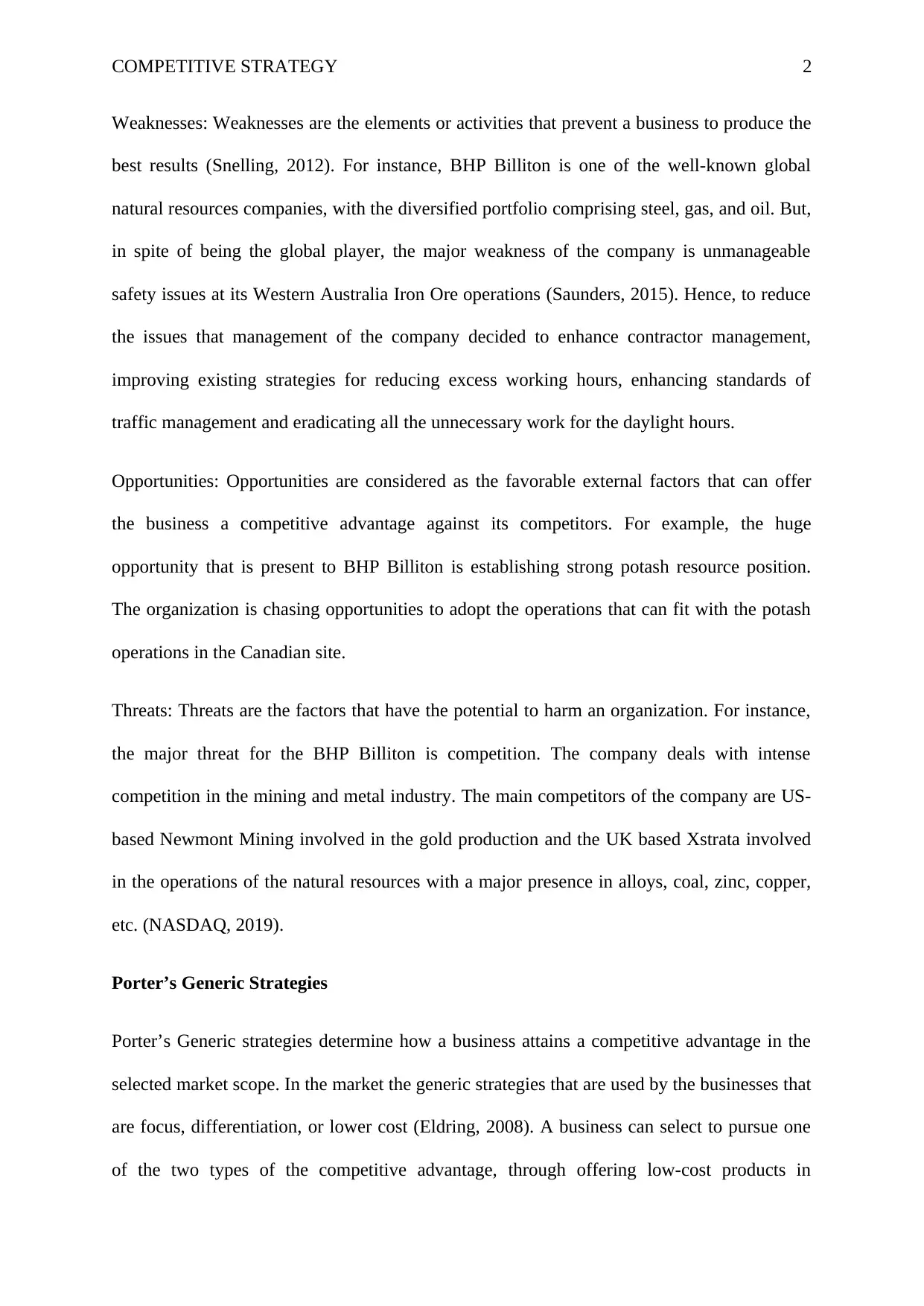
COMPETITIVE STRATEGY 2
Weaknesses: Weaknesses are the elements or activities that prevent a business to produce the
best results (Snelling, 2012). For instance, BHP Billiton is one of the well-known global
natural resources companies, with the diversified portfolio comprising steel, gas, and oil. But,
in spite of being the global player, the major weakness of the company is unmanageable
safety issues at its Western Australia Iron Ore operations (Saunders, 2015). Hence, to reduce
the issues that management of the company decided to enhance contractor management,
improving existing strategies for reducing excess working hours, enhancing standards of
traffic management and eradicating all the unnecessary work for the daylight hours.
Opportunities: Opportunities are considered as the favorable external factors that can offer
the business a competitive advantage against its competitors. For example, the huge
opportunity that is present to BHP Billiton is establishing strong potash resource position.
The organization is chasing opportunities to adopt the operations that can fit with the potash
operations in the Canadian site.
Threats: Threats are the factors that have the potential to harm an organization. For instance,
the major threat for the BHP Billiton is competition. The company deals with intense
competition in the mining and metal industry. The main competitors of the company are US-
based Newmont Mining involved in the gold production and the UK based Xstrata involved
in the operations of the natural resources with a major presence in alloys, coal, zinc, copper,
etc. (NASDAQ, 2019).
Porter’s Generic Strategies
Porter’s Generic strategies determine how a business attains a competitive advantage in the
selected market scope. In the market the generic strategies that are used by the businesses that
are focus, differentiation, or lower cost (Eldring, 2008). A business can select to pursue one
of the two types of the competitive advantage, through offering low-cost products in
Weaknesses: Weaknesses are the elements or activities that prevent a business to produce the
best results (Snelling, 2012). For instance, BHP Billiton is one of the well-known global
natural resources companies, with the diversified portfolio comprising steel, gas, and oil. But,
in spite of being the global player, the major weakness of the company is unmanageable
safety issues at its Western Australia Iron Ore operations (Saunders, 2015). Hence, to reduce
the issues that management of the company decided to enhance contractor management,
improving existing strategies for reducing excess working hours, enhancing standards of
traffic management and eradicating all the unnecessary work for the daylight hours.
Opportunities: Opportunities are considered as the favorable external factors that can offer
the business a competitive advantage against its competitors. For example, the huge
opportunity that is present to BHP Billiton is establishing strong potash resource position.
The organization is chasing opportunities to adopt the operations that can fit with the potash
operations in the Canadian site.
Threats: Threats are the factors that have the potential to harm an organization. For instance,
the major threat for the BHP Billiton is competition. The company deals with intense
competition in the mining and metal industry. The main competitors of the company are US-
based Newmont Mining involved in the gold production and the UK based Xstrata involved
in the operations of the natural resources with a major presence in alloys, coal, zinc, copper,
etc. (NASDAQ, 2019).
Porter’s Generic Strategies
Porter’s Generic strategies determine how a business attains a competitive advantage in the
selected market scope. In the market the generic strategies that are used by the businesses that
are focus, differentiation, or lower cost (Eldring, 2008). A business can select to pursue one
of the two types of the competitive advantage, through offering low-cost products in
⊘ This is a preview!⊘
Do you want full access?
Subscribe today to unlock all pages.

Trusted by 1+ million students worldwide
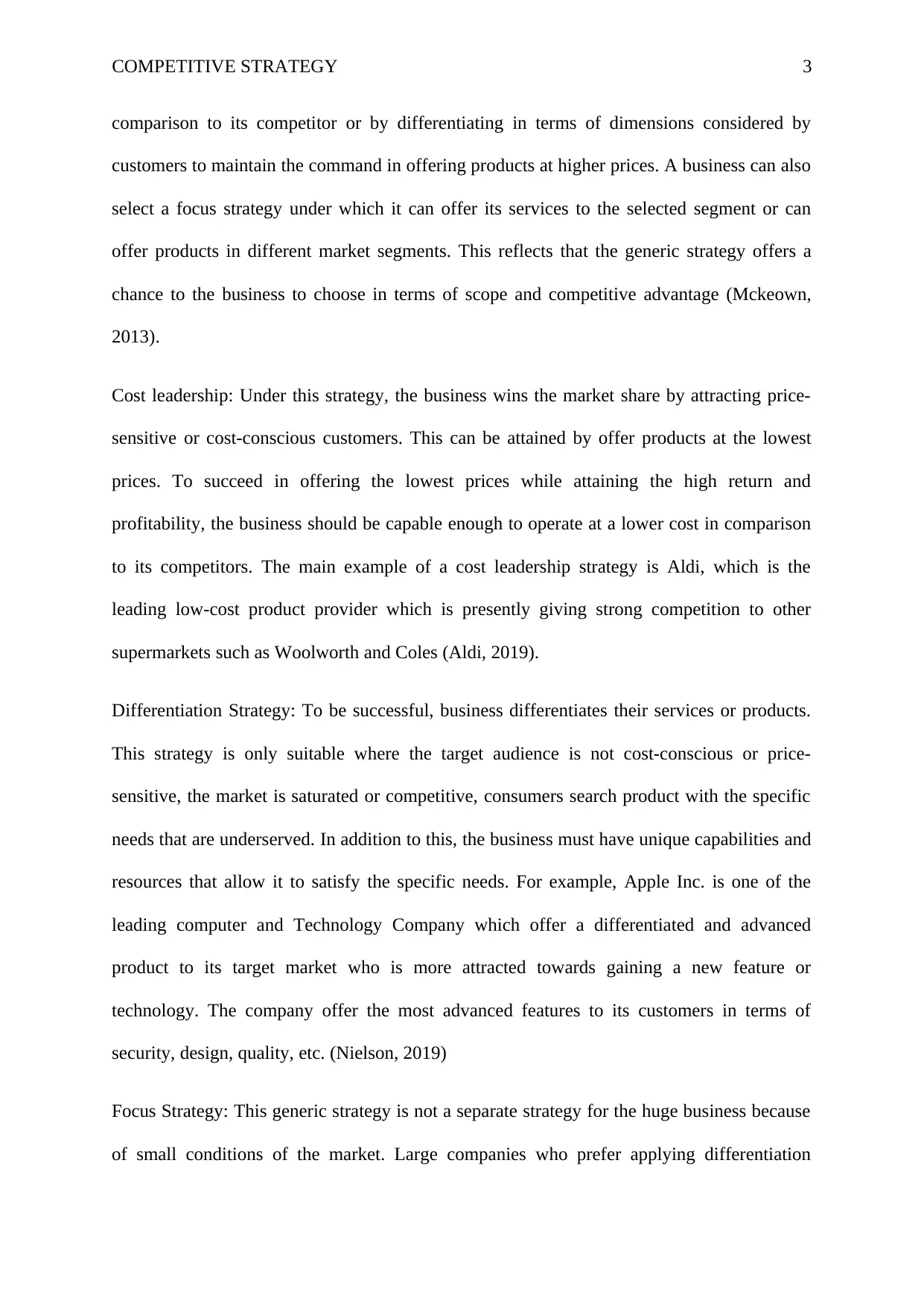
COMPETITIVE STRATEGY 3
comparison to its competitor or by differentiating in terms of dimensions considered by
customers to maintain the command in offering products at higher prices. A business can also
select a focus strategy under which it can offer its services to the selected segment or can
offer products in different market segments. This reflects that the generic strategy offers a
chance to the business to choose in terms of scope and competitive advantage (Mckeown,
2013).
Cost leadership: Under this strategy, the business wins the market share by attracting price-
sensitive or cost-conscious customers. This can be attained by offer products at the lowest
prices. To succeed in offering the lowest prices while attaining the high return and
profitability, the business should be capable enough to operate at a lower cost in comparison
to its competitors. The main example of a cost leadership strategy is Aldi, which is the
leading low-cost product provider which is presently giving strong competition to other
supermarkets such as Woolworth and Coles (Aldi, 2019).
Differentiation Strategy: To be successful, business differentiates their services or products.
This strategy is only suitable where the target audience is not cost-conscious or price-
sensitive, the market is saturated or competitive, consumers search product with the specific
needs that are underserved. In addition to this, the business must have unique capabilities and
resources that allow it to satisfy the specific needs. For example, Apple Inc. is one of the
leading computer and Technology Company which offer a differentiated and advanced
product to its target market who is more attracted towards gaining a new feature or
technology. The company offer the most advanced features to its customers in terms of
security, design, quality, etc. (Nielson, 2019)
Focus Strategy: This generic strategy is not a separate strategy for the huge business because
of small conditions of the market. Large companies who prefer applying differentiation
comparison to its competitor or by differentiating in terms of dimensions considered by
customers to maintain the command in offering products at higher prices. A business can also
select a focus strategy under which it can offer its services to the selected segment or can
offer products in different market segments. This reflects that the generic strategy offers a
chance to the business to choose in terms of scope and competitive advantage (Mckeown,
2013).
Cost leadership: Under this strategy, the business wins the market share by attracting price-
sensitive or cost-conscious customers. This can be attained by offer products at the lowest
prices. To succeed in offering the lowest prices while attaining the high return and
profitability, the business should be capable enough to operate at a lower cost in comparison
to its competitors. The main example of a cost leadership strategy is Aldi, which is the
leading low-cost product provider which is presently giving strong competition to other
supermarkets such as Woolworth and Coles (Aldi, 2019).
Differentiation Strategy: To be successful, business differentiates their services or products.
This strategy is only suitable where the target audience is not cost-conscious or price-
sensitive, the market is saturated or competitive, consumers search product with the specific
needs that are underserved. In addition to this, the business must have unique capabilities and
resources that allow it to satisfy the specific needs. For example, Apple Inc. is one of the
leading computer and Technology Company which offer a differentiated and advanced
product to its target market who is more attracted towards gaining a new feature or
technology. The company offer the most advanced features to its customers in terms of
security, design, quality, etc. (Nielson, 2019)
Focus Strategy: This generic strategy is not a separate strategy for the huge business because
of small conditions of the market. Large companies who prefer applying differentiation
Paraphrase This Document
Need a fresh take? Get an instant paraphrase of this document with our AI Paraphraser
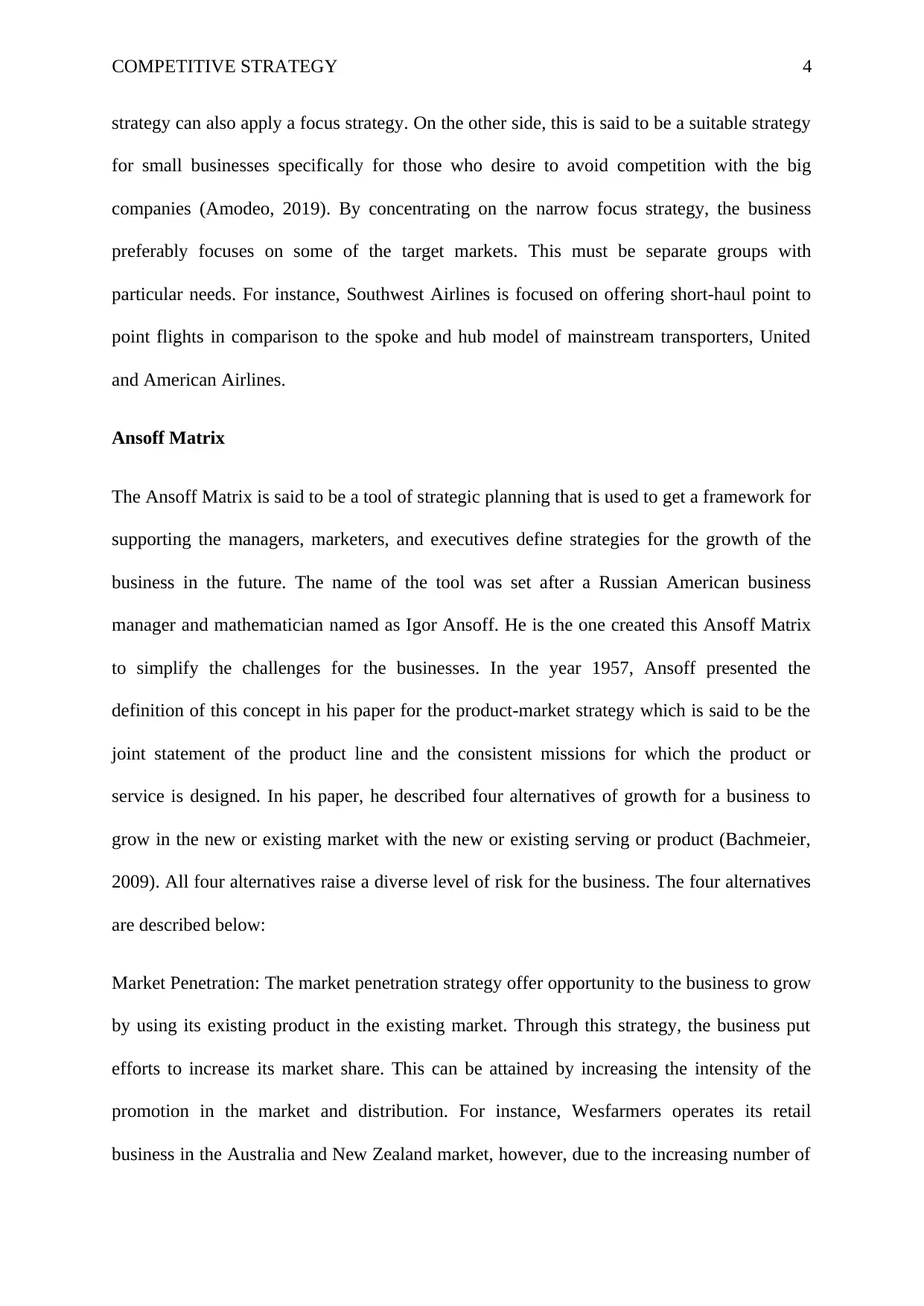
COMPETITIVE STRATEGY 4
strategy can also apply a focus strategy. On the other side, this is said to be a suitable strategy
for small businesses specifically for those who desire to avoid competition with the big
companies (Amodeo, 2019). By concentrating on the narrow focus strategy, the business
preferably focuses on some of the target markets. This must be separate groups with
particular needs. For instance, Southwest Airlines is focused on offering short-haul point to
point flights in comparison to the spoke and hub model of mainstream transporters, United
and American Airlines.
Ansoff Matrix
The Ansoff Matrix is said to be a tool of strategic planning that is used to get a framework for
supporting the managers, marketers, and executives define strategies for the growth of the
business in the future. The name of the tool was set after a Russian American business
manager and mathematician named as Igor Ansoff. He is the one created this Ansoff Matrix
to simplify the challenges for the businesses. In the year 1957, Ansoff presented the
definition of this concept in his paper for the product-market strategy which is said to be the
joint statement of the product line and the consistent missions for which the product or
service is designed. In his paper, he described four alternatives of growth for a business to
grow in the new or existing market with the new or existing serving or product (Bachmeier,
2009). All four alternatives raise a diverse level of risk for the business. The four alternatives
are described below:
Market Penetration: The market penetration strategy offer opportunity to the business to grow
by using its existing product in the existing market. Through this strategy, the business put
efforts to increase its market share. This can be attained by increasing the intensity of the
promotion in the market and distribution. For instance, Wesfarmers operates its retail
business in the Australia and New Zealand market, however, due to the increasing number of
strategy can also apply a focus strategy. On the other side, this is said to be a suitable strategy
for small businesses specifically for those who desire to avoid competition with the big
companies (Amodeo, 2019). By concentrating on the narrow focus strategy, the business
preferably focuses on some of the target markets. This must be separate groups with
particular needs. For instance, Southwest Airlines is focused on offering short-haul point to
point flights in comparison to the spoke and hub model of mainstream transporters, United
and American Airlines.
Ansoff Matrix
The Ansoff Matrix is said to be a tool of strategic planning that is used to get a framework for
supporting the managers, marketers, and executives define strategies for the growth of the
business in the future. The name of the tool was set after a Russian American business
manager and mathematician named as Igor Ansoff. He is the one created this Ansoff Matrix
to simplify the challenges for the businesses. In the year 1957, Ansoff presented the
definition of this concept in his paper for the product-market strategy which is said to be the
joint statement of the product line and the consistent missions for which the product or
service is designed. In his paper, he described four alternatives of growth for a business to
grow in the new or existing market with the new or existing serving or product (Bachmeier,
2009). All four alternatives raise a diverse level of risk for the business. The four alternatives
are described below:
Market Penetration: The market penetration strategy offer opportunity to the business to grow
by using its existing product in the existing market. Through this strategy, the business put
efforts to increase its market share. This can be attained by increasing the intensity of the
promotion in the market and distribution. For instance, Wesfarmers operates its retail
business in the Australia and New Zealand market, however, due to the increasing number of
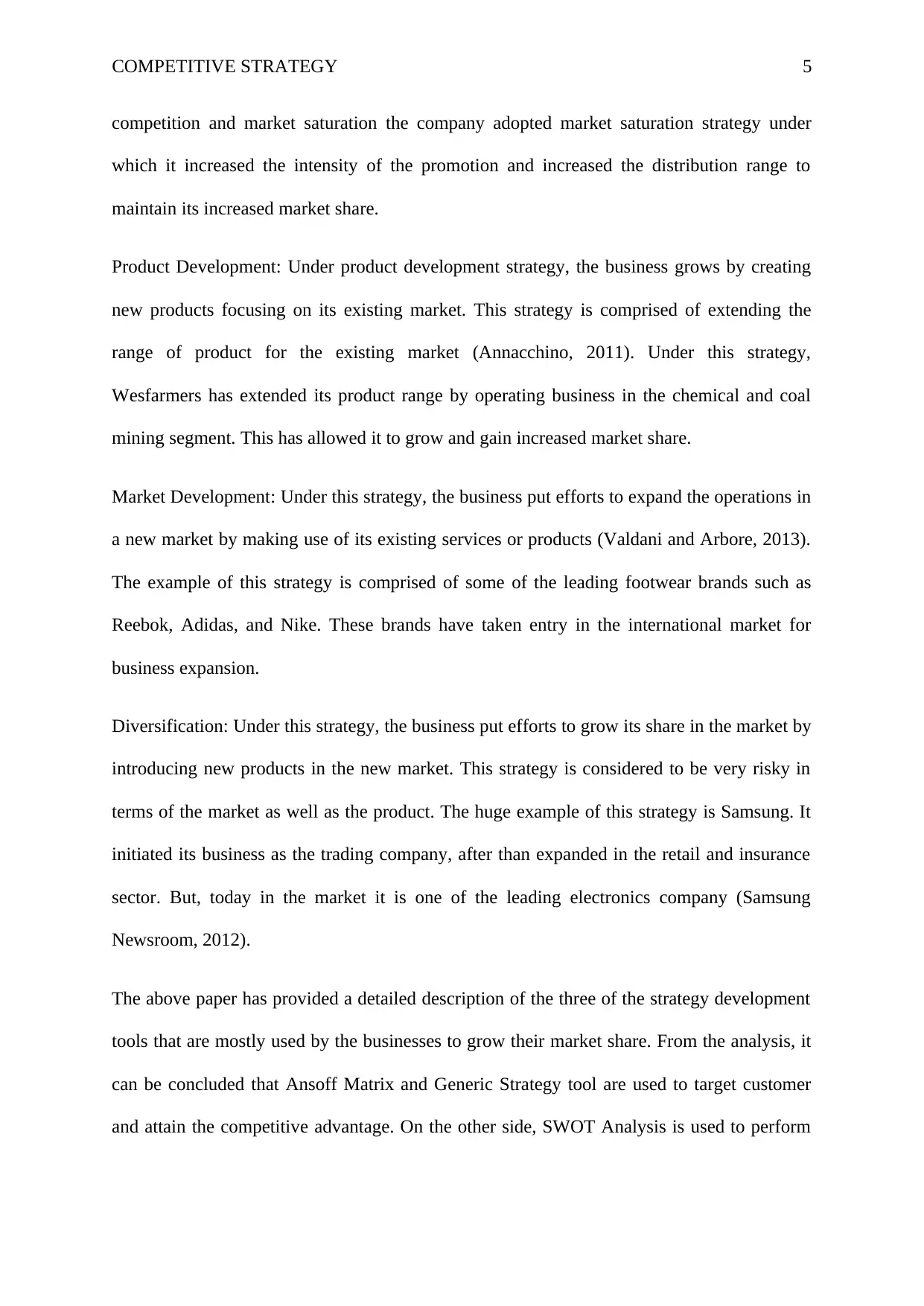
COMPETITIVE STRATEGY 5
competition and market saturation the company adopted market saturation strategy under
which it increased the intensity of the promotion and increased the distribution range to
maintain its increased market share.
Product Development: Under product development strategy, the business grows by creating
new products focusing on its existing market. This strategy is comprised of extending the
range of product for the existing market (Annacchino, 2011). Under this strategy,
Wesfarmers has extended its product range by operating business in the chemical and coal
mining segment. This has allowed it to grow and gain increased market share.
Market Development: Under this strategy, the business put efforts to expand the operations in
a new market by making use of its existing services or products (Valdani and Arbore, 2013).
The example of this strategy is comprised of some of the leading footwear brands such as
Reebok, Adidas, and Nike. These brands have taken entry in the international market for
business expansion.
Diversification: Under this strategy, the business put efforts to grow its share in the market by
introducing new products in the new market. This strategy is considered to be very risky in
terms of the market as well as the product. The huge example of this strategy is Samsung. It
initiated its business as the trading company, after than expanded in the retail and insurance
sector. But, today in the market it is one of the leading electronics company (Samsung
Newsroom, 2012).
The above paper has provided a detailed description of the three of the strategy development
tools that are mostly used by the businesses to grow their market share. From the analysis, it
can be concluded that Ansoff Matrix and Generic Strategy tool are used to target customer
and attain the competitive advantage. On the other side, SWOT Analysis is used to perform
competition and market saturation the company adopted market saturation strategy under
which it increased the intensity of the promotion and increased the distribution range to
maintain its increased market share.
Product Development: Under product development strategy, the business grows by creating
new products focusing on its existing market. This strategy is comprised of extending the
range of product for the existing market (Annacchino, 2011). Under this strategy,
Wesfarmers has extended its product range by operating business in the chemical and coal
mining segment. This has allowed it to grow and gain increased market share.
Market Development: Under this strategy, the business put efforts to expand the operations in
a new market by making use of its existing services or products (Valdani and Arbore, 2013).
The example of this strategy is comprised of some of the leading footwear brands such as
Reebok, Adidas, and Nike. These brands have taken entry in the international market for
business expansion.
Diversification: Under this strategy, the business put efforts to grow its share in the market by
introducing new products in the new market. This strategy is considered to be very risky in
terms of the market as well as the product. The huge example of this strategy is Samsung. It
initiated its business as the trading company, after than expanded in the retail and insurance
sector. But, today in the market it is one of the leading electronics company (Samsung
Newsroom, 2012).
The above paper has provided a detailed description of the three of the strategy development
tools that are mostly used by the businesses to grow their market share. From the analysis, it
can be concluded that Ansoff Matrix and Generic Strategy tool are used to target customer
and attain the competitive advantage. On the other side, SWOT Analysis is used to perform
⊘ This is a preview!⊘
Do you want full access?
Subscribe today to unlock all pages.

Trusted by 1+ million students worldwide
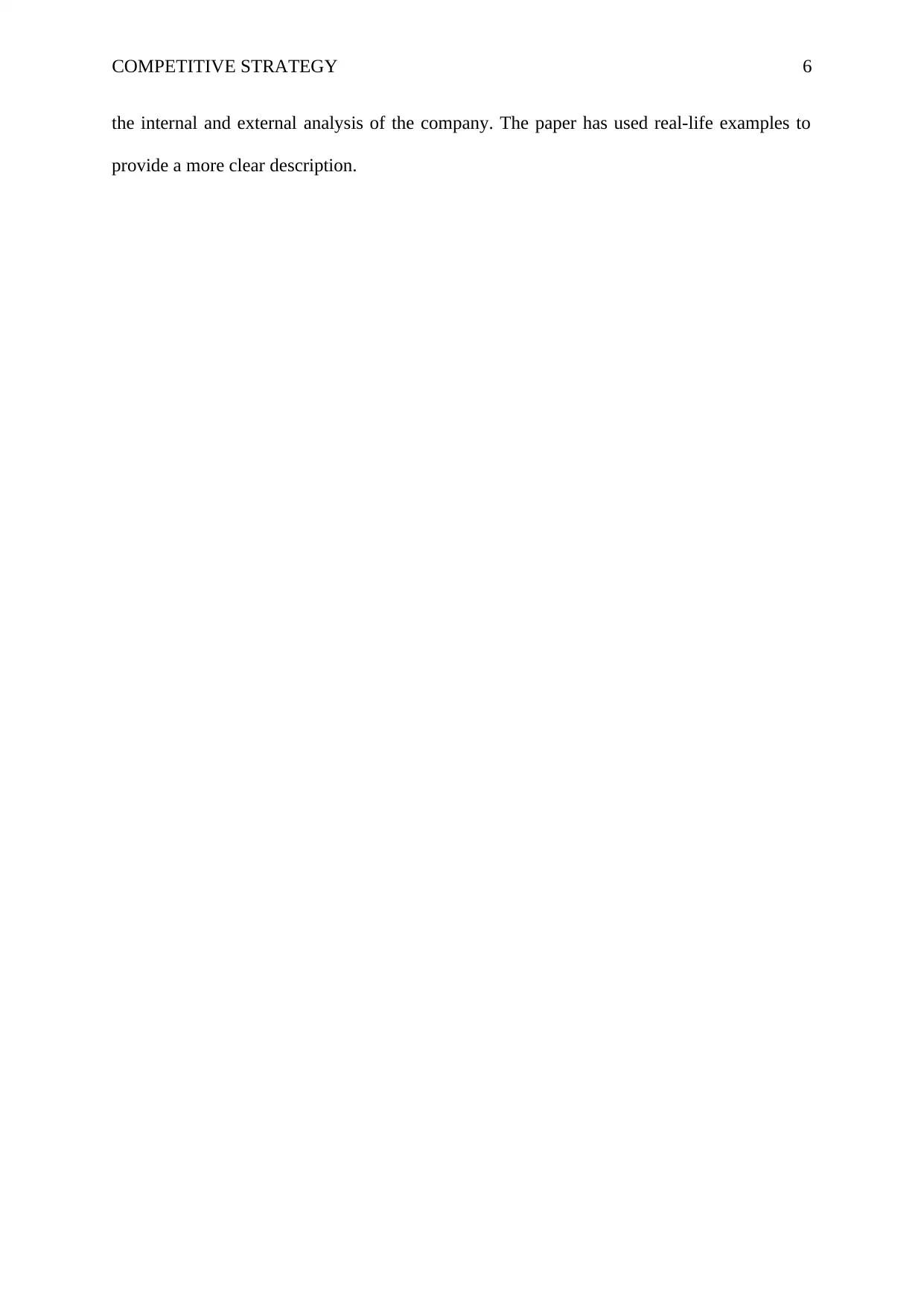
COMPETITIVE STRATEGY 6
the internal and external analysis of the company. The paper has used real-life examples to
provide a more clear description.
the internal and external analysis of the company. The paper has used real-life examples to
provide a more clear description.
Paraphrase This Document
Need a fresh take? Get an instant paraphrase of this document with our AI Paraphraser
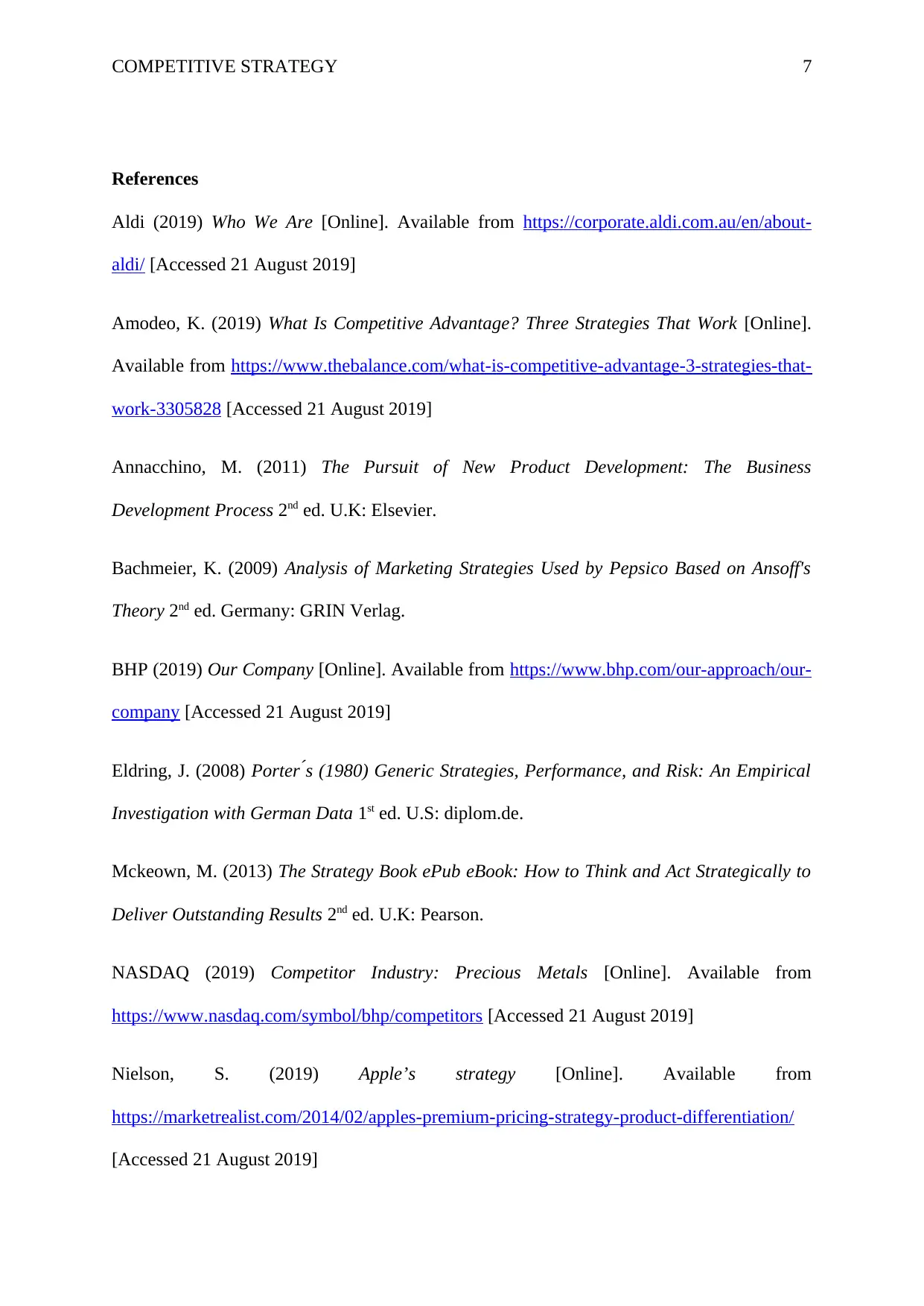
COMPETITIVE STRATEGY 7
References
Aldi (2019) Who We Are [Online]. Available from https://corporate.aldi.com.au/en/about-
aldi/ [Accessed 21 August 2019]
Amodeo, K. (2019) What Is Competitive Advantage? Three Strategies That Work [Online].
Available from https://www.thebalance.com/what-is-competitive-advantage-3-strategies-that-
work-3305828 [Accessed 21 August 2019]
Annacchino, M. (2011) The Pursuit of New Product Development: The Business
Development Process 2nd ed. U.K: Elsevier.
Bachmeier, K. (2009) Analysis of Marketing Strategies Used by Pepsico Based on Ansoff's
Theory 2nd ed. Germany: GRIN Verlag.
BHP (2019) Our Company [Online]. Available from https://www.bhp.com/our-approach/our-
company [Accessed 21 August 2019]
Eldring, J. (2008) Porter ́ s (1980) Generic Strategies, Performance, and Risk: An Empirical
Investigation with German Data 1st ed. U.S: diplom.de.
Mckeown, M. (2013) The Strategy Book ePub eBook: How to Think and Act Strategically to
Deliver Outstanding Results 2nd ed. U.K: Pearson.
NASDAQ (2019) Competitor Industry: Precious Metals [Online]. Available from
https://www.nasdaq.com/symbol/bhp/competitors [Accessed 21 August 2019]
Nielson, S. (2019) Apple’s strategy [Online]. Available from
https://marketrealist.com/2014/02/apples-premium-pricing-strategy-product-differentiation/
[Accessed 21 August 2019]
References
Aldi (2019) Who We Are [Online]. Available from https://corporate.aldi.com.au/en/about-
aldi/ [Accessed 21 August 2019]
Amodeo, K. (2019) What Is Competitive Advantage? Three Strategies That Work [Online].
Available from https://www.thebalance.com/what-is-competitive-advantage-3-strategies-that-
work-3305828 [Accessed 21 August 2019]
Annacchino, M. (2011) The Pursuit of New Product Development: The Business
Development Process 2nd ed. U.K: Elsevier.
Bachmeier, K. (2009) Analysis of Marketing Strategies Used by Pepsico Based on Ansoff's
Theory 2nd ed. Germany: GRIN Verlag.
BHP (2019) Our Company [Online]. Available from https://www.bhp.com/our-approach/our-
company [Accessed 21 August 2019]
Eldring, J. (2008) Porter ́ s (1980) Generic Strategies, Performance, and Risk: An Empirical
Investigation with German Data 1st ed. U.S: diplom.de.
Mckeown, M. (2013) The Strategy Book ePub eBook: How to Think and Act Strategically to
Deliver Outstanding Results 2nd ed. U.K: Pearson.
NASDAQ (2019) Competitor Industry: Precious Metals [Online]. Available from
https://www.nasdaq.com/symbol/bhp/competitors [Accessed 21 August 2019]
Nielson, S. (2019) Apple’s strategy [Online]. Available from
https://marketrealist.com/2014/02/apples-premium-pricing-strategy-product-differentiation/
[Accessed 21 August 2019]
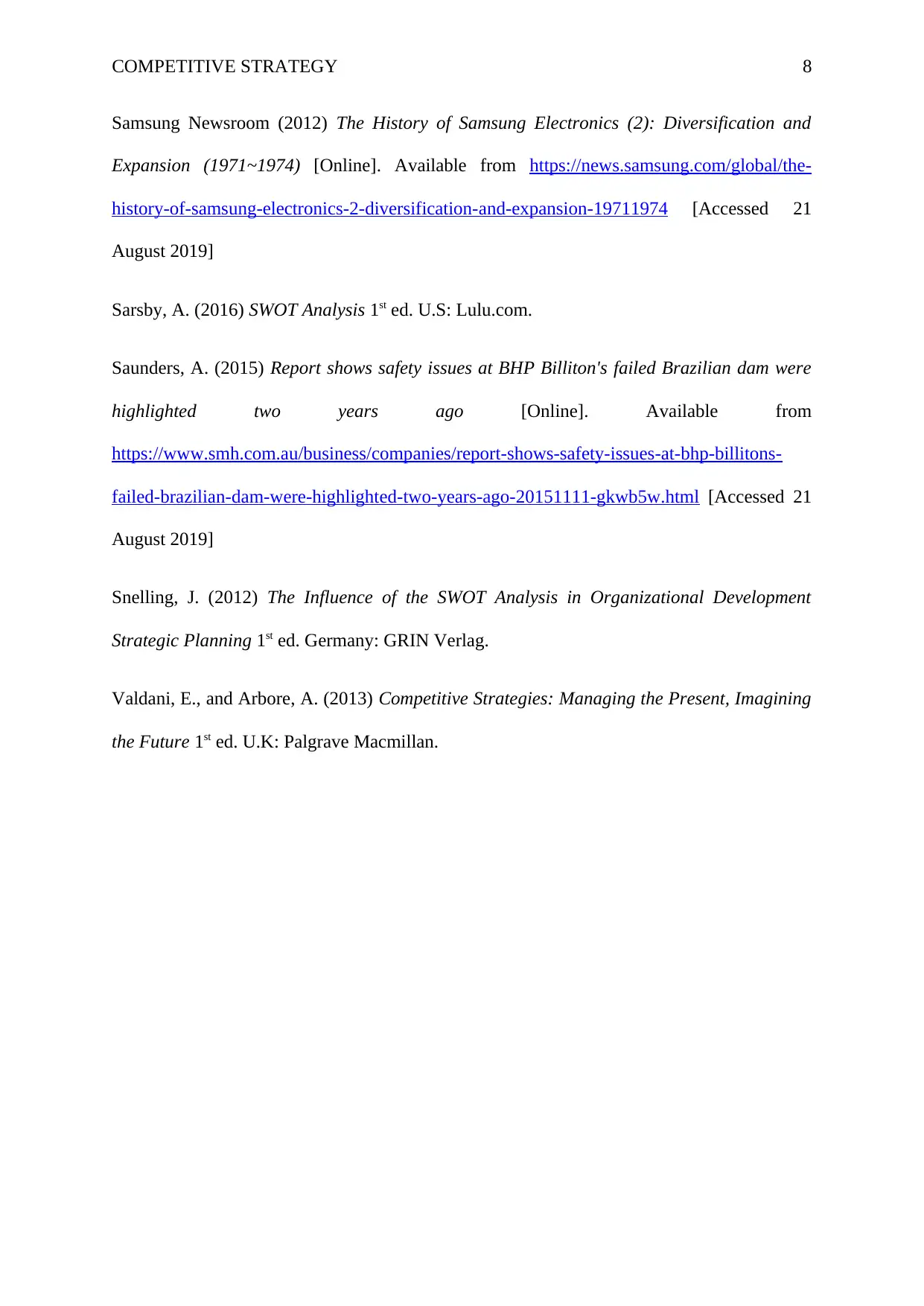
COMPETITIVE STRATEGY 8
Samsung Newsroom (2012) The History of Samsung Electronics (2): Diversification and
Expansion (1971~1974) [Online]. Available from https://news.samsung.com/global/the-
history-of-samsung-electronics-2-diversification-and-expansion-19711974 [Accessed 21
August 2019]
Sarsby, A. (2016) SWOT Analysis 1st ed. U.S: Lulu.com.
Saunders, A. (2015) Report shows safety issues at BHP Billiton's failed Brazilian dam were
highlighted two years ago [Online]. Available from
https://www.smh.com.au/business/companies/report-shows-safety-issues-at-bhp-billitons-
failed-brazilian-dam-were-highlighted-two-years-ago-20151111-gkwb5w.html [Accessed 21
August 2019]
Snelling, J. (2012) The Influence of the SWOT Analysis in Organizational Development
Strategic Planning 1st ed. Germany: GRIN Verlag.
Valdani, E., and Arbore, A. (2013) Competitive Strategies: Managing the Present, Imagining
the Future 1st ed. U.K: Palgrave Macmillan.
Samsung Newsroom (2012) The History of Samsung Electronics (2): Diversification and
Expansion (1971~1974) [Online]. Available from https://news.samsung.com/global/the-
history-of-samsung-electronics-2-diversification-and-expansion-19711974 [Accessed 21
August 2019]
Sarsby, A. (2016) SWOT Analysis 1st ed. U.S: Lulu.com.
Saunders, A. (2015) Report shows safety issues at BHP Billiton's failed Brazilian dam were
highlighted two years ago [Online]. Available from
https://www.smh.com.au/business/companies/report-shows-safety-issues-at-bhp-billitons-
failed-brazilian-dam-were-highlighted-two-years-ago-20151111-gkwb5w.html [Accessed 21
August 2019]
Snelling, J. (2012) The Influence of the SWOT Analysis in Organizational Development
Strategic Planning 1st ed. Germany: GRIN Verlag.
Valdani, E., and Arbore, A. (2013) Competitive Strategies: Managing the Present, Imagining
the Future 1st ed. U.K: Palgrave Macmillan.
⊘ This is a preview!⊘
Do you want full access?
Subscribe today to unlock all pages.

Trusted by 1+ million students worldwide
1 out of 9
Related Documents
Your All-in-One AI-Powered Toolkit for Academic Success.
+13062052269
info@desklib.com
Available 24*7 on WhatsApp / Email
![[object Object]](/_next/static/media/star-bottom.7253800d.svg)
Unlock your academic potential
Copyright © 2020–2025 A2Z Services. All Rights Reserved. Developed and managed by ZUCOL.





